Remanufacture, refurbishment, reuse and recycling of vehicles: trends and opportunities
This report describes the short, medium and long term trends related to the remanufacturing, refurbishment, reuse and recycling of vehicles, parts and components in Scotland.
8. Short term commercial opportunities
This section provides a description and quantitative comparison of three short term opportunities. The specification of these opportunities was agreed with the project steering group prior to commencement of the modelling.
This section describes the following assessment of short term opportunities:
- Establishment of a spreadsheet based model to compare baseline and models
- Quantification of the economic and environmental impacts of a business as usual scenario
- Modelling and comparison of scenarios which reflect three
short term opportunities
- Post shredder technology recycling and recovery plant
- ASR plasma gasification plant
- 50% increase in parts reuse
The first two of the above short term opportunities address the issue of how to recycle and recovery the residual waste from shredding operations in order to meet the 2015 ELV Directive targets. The third opportunity relates to ELV dismantlers achieving a 50% increase in parts recovered and then sold for reuse (without any repair, refurbishment or remanufacture).
The increased reuse of parts from ELV dismantlers is a short term opportunity which aligns well with the medium to longer term opportunities described in the previous section. The capabilities required to remove, categorise and store parts is an important early stage in the subsequent development of more advance disassembly operations.
The other two short term opportunities relate to the mechanical separation and/or energy recovery of mixed residual waste from mechanical shredder and separation plants. It can be argued that this may not be as well aligned with the potential future supply chain described in the previous section. As medium and long term trends lead to higher levels of resource efficiency there will be higher levels of repair, refurbishment and remanufacture of vehicles and parts. In the future supply chain described earlier ( figure 42), the emergence of semi-automated vehicle disassembly plants would lead to less material being sent for shredding and sorting. As a result there would be less of a feedstock for automated shredder residue recycling and recovery plant and plasma gasification facilities.
A significant unknown factor in this comparison of short, medium and long term opportunities is the timescales involved in the development of new supply chains. The time taken for new circular economy business models to develop is uncertain. The extent to which pursuing a short term opportunity now might lock the market into energy recovery technologies (at the expense of remanufacture, refurbishment, repair and recycling technologies and practices) is also unknown. It could be argued that over the medium to long term the market pull for recovered parts and components for remanufacture will reduce the flow of material to shredders (and therefore shredder residue to recycling and recovery based treatment facilities). The commercial risk is, therefore, with the shredder facilities and investors in new shredder residue treatment plants. If the move to a circular economy occurs quickly then there is a risk that changes to material flow will occur before investments in shredder residue treatment plants are paid back. If the move to a circular economy takes longer then current investments in new facilities will have time to achieve payback.
It is not obvious, however, that the presence of new shredder residue treatment facilities (which involve part, or all, of the material going to energy from waste) would lock ELV dismantlers into using them to the detriment of market developments in increased reuse, repair, refurbishment or remanufacture of parts and components. ELV dismantlers are highly unlikely to enter into long term agreements to supply shredders. Shredders are also highly unlikely to enter into long term supply contracts with shredder residue treatment facilities. This means that ELV dismantlers should be able to respond to market price signals for additional recovery of parts in the short term. In the medium to longer term, the previous description of the supply chain suggests the emergence of larger scale disassembly plants which are able to economically recovery a greater number of parts and components. If this occurs then the presence of shredder residue treatment plants is unlikely to be a barrier to them pursuing this increased parts and component recovery.
8.1 A model to compare short term opportunitiesA spreadsheet based model was developed to enable comparison of short term opportunities. The model is intended to provide baseline data on the number of ELVs arising in Scotland and projections of ELV numbers, weights and material composition to 2030.
The model also projects the number of end-of-life electric and plug-in hybrid batteries. It is available as a separate MS Excel spreadsheet.
8.1.1 Key modelling assumptions
The key aspects of the model include:
- Baseline arisings data
- Future trends in ELV arisings and capture rates
- Trends in hybrid and electric vehicle stock
- Current and projected average vehicle weight
- Current and projected composition
- Recycling and recovery rates
- Gross value and costs
- Environmental impact
The assumptions used in the model are detailed in the remainder of this section.
Baseline arisings data
The model uses baseline information on ELV arisings (based on Certificate of Destruction data) provided by BIS. The 2011 data indicate that 96,717 CODs were issued by Scottish based ATFs.
Future trends in ELV arisings and capture rates
The number of ELVs arriving at Scottish based ATFs in future is likely to be a function of a number of factors:
- The number of new vehicles registered
- The total number of vehicles licensed
- Exports of ELVs from Scotland
- Illegal disposal of ELVs with no COD issued (using operators not registered as ATFs)
Data on the first two of these factors is readily available, as can be seen in figure 43.
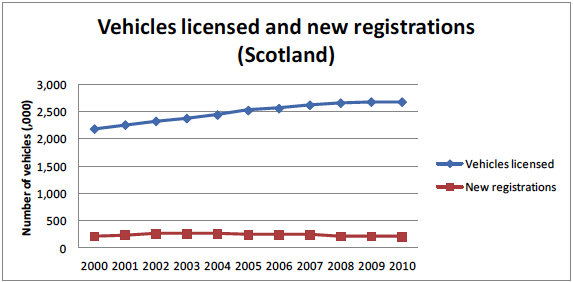
Figure 43 - Trends in vehicles licensed and new registrations in Scotland (2000 to 2010) [88]
The data behind the above figure is shown below:

Figure 44 - Number of vehicles licensed and number of new registrations in Scotland (000's)
Between 2009 and 2010 there were 209,000 new vehicle registrations in Scotland. In the same period, the total number of vehicles licensed in Scotland increased by only 1,000 (calculated by subtracting the 2,684,000 vehicles licensed in 2009 from the 2,685,000 vehicles licensed in 2010, from figure 44, above). It could reasonably be assumed that this equates to 208,000 vehicles being deregistered. This deregistration could occur through dismantling via an ATF, exporting or through treatment via unauthorised operators.
Given that ELV arisings in Scotland in 2009 are (based on the number of CODs issued) estimated to be 110,677 vehicles [89] , then one interpretation of the data is that just under 100,000 vehicles (208,000 less 110,677) were exported (as working vehicles) or processed through non- ATF registered channels ( e.g. potentially exported as scrap metal without proper ELV depollution processes being carried out).
Due to the difficulties in identifying the actual capture rates of ELVs, the projection model developed as part of this project assumes no change in the 'leakage rate' of ELVs to unauthorised operators. Future ELV arisings are assumed to be correlated to increases in number of new vehicles registered and the baseline for applying these changes will be the 2011 figure of ELVs being processed by ATFs of 96,717 vehicles. Note that the 2010 estimate of ELVs treated is 93,112 [90] .
A study [91] carried out for the European Environment Agency estimates that, between 2005 and 2030, the number of ELVs arising in EU15 countries is expected to rise by 1.4% p.a. (note this assumes a GDP growth of 1.8% p.a. in GDP). This report highlights that the model does not take into account exports of ELVs and goes on to compare with a similar calculation by the GHK/Bio Services Intelligence report [92] (that includes exporting and covers the period to 2015). This comparison indicates that the medium to long term figure of 1.4% p.a. growth of ELVs may be on the high side as the GHK/Bio Services Intelligence report projects a 2015 ELV arisings figure for the EU that is 11% lower than the former study projected.
In the short term it is also useful to consider recent forecast data on new vehicle registrations in the UK:
- New vehicle registrations in the UK are up by 1.6% in 2012 (compared to 2011) and new vehicle registrations in the UK are up by 1.0% in 2013 (compared to 2012) (forecasts) [93]
New vehicle registrations and ELV arisings are unlikely to be perfectly correlated. The model developed for this project is, for simplicity, based on the assumption that the rate of growth of new vehicle registrations is equal to growth in ELV arisings (in the years where these forecasts exist, i.e. 2012 and 2013). The model also assumes that in the period 2014 to 2030 the growth rate will be less than that used in the GHK/Bio Services Intelligence report. This is based on lower GDP growth rate in the short term and to account for a proportion of ELVs being exported from the UK.
Taking into account the above data and assumptions, the projection model will apply the following annual changes to the 2011 figure of 96,717 ELV arisings in Scotland:
- 2012 - 1.6% increase
- 2013 - 1.0% increase
- 2014 to 2030 - 1.0% increase (being a lower estimate than the 1.4% referred to above taking into account the lower comparison of the GHK/Bio Services report, which takes into account exports)
Trends in hybrid and electric vehicle stock
A study by [then] BERR and the DfT on the timing and scale of consumer adoption of Electric Vehicles ( EV) and Plug-in Hybrid Electric Vehicles ( PHEV) can be used as a basis for estimating the number of these types of vehicle in the ELV stream [94] .
Various scenarios were presented in this study. The Business As Usual ( BAU) scenario is used for the purposes of this report. The BAU scenario assumes that current incentives are left in place with no additional support. Battery costs are such that whole life cost parity with conventional cars would not be achieved until around 2020. Up until this point, growth is limited to congestion zones such as London and amongst green consumers. The model assumes that the rate of adoption in Scotland is the same as the UK. It may be that the actual rate is less in Scotland if the initial growth in EV and PHEV occurs in congestion zones such as London.
Figure 45, below illustrates the gradual increase in adoption in the UK.

Figure 45 - Projected trends in numbers and percentages of EVs and PHEVs (to 2030)
The part of these vehicles containing most rare earth elements is the battery, which also contains significant amounts of nickel, steel and cobalt (Ni- MH batteries) or lithium, copper, aluminium and cobalt (Li-ion batteries). The projected life-span of batteries is estimated at around 8 years (less that the life of the overall vehicle) [95] . At this stage the options include using the batteries for secondary applications such as storage of off-peak electricity generated from renewables ( e.g. solar PV or wind) or recycling via pyrometallurgical or hydrometallurgical processes.
To account for the projected 8 year lifespan, the number of batteries from EV and PHEV in the model lags the sales of EV and PHEV by 8 years.
Based on the above assumptions, it is projected that, in Scotland:
- By 2020 there will be approximately 500 EV batteries and 1,700 PHEV batteries reaching end of life for vehicle use p.a.
- By 2025 there will be approximately 650 EV batteries and 2,000 PHEV batteries reaching end of life for vehicle use p.a.
- By 2030 there will be approximately 3,800 EV batteries and 20,000 PHEV batteries reaching end of life for vehicle use p.a.
Current and projected average vehicle weight
The GSK/Bio Intelligence Services report [96] for the EU provides estimates of increasing vehicle weight up to 2015, which is used in the model. This states that average vehicle weights of ELV are:
- 2011 - 1,005kg
- 2012 - 1,010kg
- 2013 - 1,015kg
- 2014 - 1,020kg
- 2015 - 1,025kg
A further reference for the increasing weight of ELVs suggests that the "weighted average for all car manufacturers show higher weights of ELVs, e.g. of approximately 1,280 kg by 2019 (being the average weight of vehicle put on the market in 2006") [97] .
The model, therefore, shows a straight line increase from 2015 to 2019 to reach the 1,280kg and then remains static thereafter (in the absence of further evidence).
Current and projected composition
Historically, there has been a gradual change in the composition of ELVs: "It is widely known that the composition of ELVs is changing, in particular an increase in weight of non-ferrous metals and plastics instead of ferrous is expected" [98] . Figure 46, overleaf, illustrates this trend.
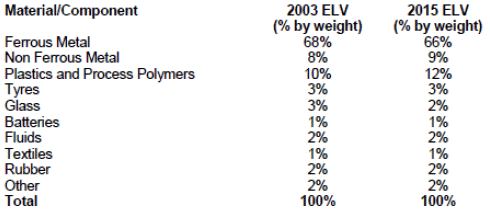
Figure 46 - Average material compositions of vehicles produced in 1985 (Vehicle 1) and 1998 (Vehicle 2) [99]
Projecting forward, this trend is assumed to continue, based on the data in figure 47, below.
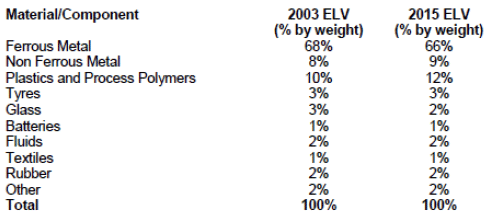
Figure 47 - Typical composition of a 2003 ELV and a 2003 new vehicle (and therefore a 2015 ELV) by weight, UK [100]
The model assumes the following composition for 2011 projections:
- Ferrous metal - 66.8%
- Non-ferrous metal - 8.6%
- Plastics - 11.2%
- Tyres - 3%
- Glass - 2.4%
- Batteries - 1%
- Fluids - 2%
- Textiles - 1%
- Rubber - 2%
- Other 2%
This increases gradually to the 2015 data in the above figure. No evidence was identified for any subsequent changes in composition post 2015 and, therefore, the data, remains static to 2030.
Recycling and recovery rates
The following figure shows the assumed reuse, recycling and recovery rates by material from a typical vehicle. The source study developed different scenarios for total reuse, recycling and recovery and this report uses the 'advanced standards of ELV treatment' that achieves a rate of 83.5% [101] :
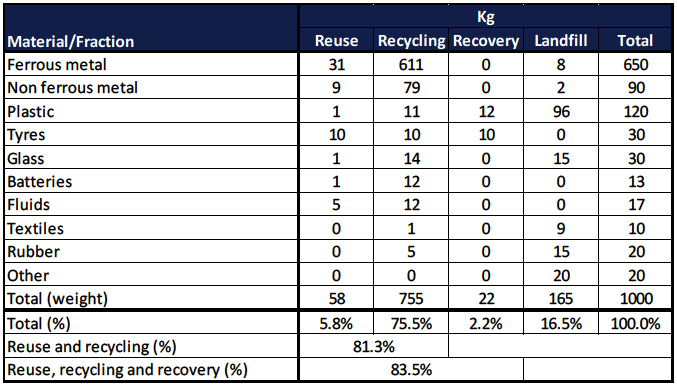
Figure 48 - Baseline treatment rates by material/fraction
The 83.5% overall reuse, recycling and recovery rate is consistent with the 2009 data for the UK found in the Eurostat database [102] (with the reuse and recycling rate being 82.1%). The equivalent data for 2010 is 85.6% for reuse, recycling and recovery (with 83% reuse and recycling). This data shows an increase in overall reuse, recycling and recovery rate of 2.1% (1.2% coming from recovery and 0.9% from reuse and recycling).
The increase in reuse, recycling and recovery rates in the UK are assumed to be driven by developments in Post Shredder Technology in plants based in England. The rates in figure 48 are, therefore, used as a baseline performance for Scotland in the model developed as part of this project.
Gross values and costs used in the business as usual scenario
The following estimates of values and costs associated with ELV treatment are used in the modelling of the 'business as usual' scenario. These estimates have been established following discussions with the ELV dismantling and shredding industry and material reprocessors.
1. Average value achieved from component and parts reuse = £100 per vehicle
2. Income received from reuse of ferrous metal is already included in component/parts revenue
3. Recycling of ferrous metal attracts an average income of £260 per tonne
4. Income received from reuse of non ferrous metal is already included in component/parts revenue
5. Recycling of non ferrous metal attracts an average income of £1,000 per tonne
6. Income received from reuse of plastics is already included in component/parts revenue
7. Recycling of baled plastics ( e.g. bumpers) attracts an income of £60 per tonne. Other feedback from the industry suggests that if bumpers are not baled they may be uplifted free of charge by plastic reprocessors. The model uses a figure of £30 to reflect the mix between baled and loose plastic. Given that this is less than the price that could be achieved if left in the vehicle for shredding it is assumed this occurs where plastic parts have been removed for resale but this has not been achieved
8. Recovery of plastics predominately occurs where plastic components attached to engines and gearboxes are sent for smelting and the plastic self fuels part of the smelting process. In this situation the plastic parts are assumed to achieve a value of £300 per tonne, which is an estimated value for engines sent for recycling (where the plastic parts are part of the overall engine weight). The model assumes that 10% of plastic recovered is through the smelting of engines and gearboxes and, therefore, the model uses a figure of £30 applied to total weight of plastics classed as recovered
9. Tyre disposal costs to the dismantler (regardless of whether they are reused, recycled or used for energy recovery) are assumed to be £0.75 per tyre
10. Income received from reuse of glass is already included in component/parts revenue
11. Income from glass recycling is assumed to be associated with the use of glass as an aggregate. The aggregate would be a fine fill material that is assumed to be provided free of charge
12. Income received from reuse of batteries is already included in component/parts revenue
13. Income from battery recycling is based on the value of the metal contained in the battery (predominately lead from lead-acid batteries). This is already taken account of in the income from metal. The weight attributed to battery recycling is based on the average non-metallic element of 4kg per battery. It is assumed that no additional income is obtained from this material by the dismantler as they are paid for the metal content
14. Income from the reuse and recycling of fluids is assumed to be zero as many waste management companies offer to take all fluids along with contaminated rags for free from the dismantlers
15. Income from textile recycling is estimated at £10 per tonne based on discussions with textile recyclers (which indicated that there are limited markets for this type of material). Given that this is less than the price that could be achieved if left in the vehicle for shredding it is assumed that this occurs where parts containing textiles have been removed for resale but this has not been achieved
16. The income from (non-tyre) rubber recycling is assumed to be similar to that achieved for plastics, i.e. £30 per tonne. Given that this is less than the price that could be achieved if left in the vehicle for shredding it is assumed that this occurs where parts containing rubber have been removed for resale but this has not been achieved
17. Landfill for ASR - the fines and light fraction are currently used as a daily cover material and, therefore, attracts a minimal gate fee and the overall cost is mainly to cover the Landfill Tax. As Landfill Tax increases in April each year the following rates have been adjusted to apply to a calendar year in the model:

Figure 49 - Estimated annual landfill charge (tax + gate fee) for ASR disposal
18. No account has been made for any further rises in landfill tax or changes to the ability of landfill operators to use ASR as capping material. Similarly the model assumes no changes to commodity prices or other disposal costs.
Environmental impact
The environmental impact of baseline and alternative scenarios will be calculated using the following 'per tonne' data from figure 50, below.
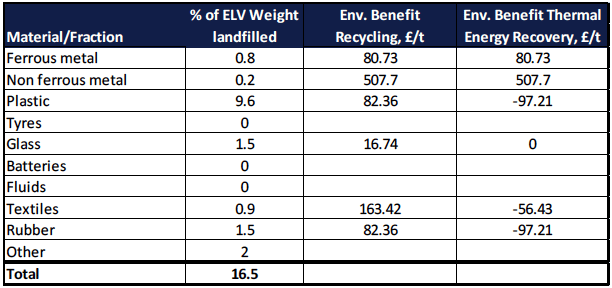
Figure 50 - Unit Environmental Benefits from Recycling and Thermal Treatment with Energy Recovery (£ per tonne waste) Positive Value means a Benefit [103]
The environmental cost/benefit of scenarios where material is diverted from landfill (to either recycling or thermal recovery) is calculated using the above data. The environmental benefits of reuse were not quantified in the source report due to lack of available data. The environmental benefits of reuse are, therefore, not included in this analysis beyond a stated reduction in weight of material sent to landfill. It should also be noted that the positive values used for energy recovery of ferrous and non ferrous metal assumes that the metal is recovered from the ash and then recycled.
8.1.2 Model limitationsA necessary step in developing any model is to simplify what actually occurs in reality. This has resulted in the model having a number of limitations, including the following:
1. The reuse, recycling and recovery rates used are based on UK wide data for 2009. It has been assumed that the Scottish rates for 2011 are consistent with this due to limited non-metallic PST investment in Scotland. The exact rates are unknown and this creates uncertainty in the projections
2. The baseline assumptions of ELVs treated use data on Certificates of Destruction issued. There is considerable uncertainty associated with this approach as significant numbers of vehicles are likely to have been processed without Certificates of Destruction being issued
3. The model only includes costs associated with disposal of tyres and residual material to landfill. It does not include either capital investment costs or other operating costs of different scenarios. These are considered separately when comparing the various scenarios
4. Historical patterns suggest that commodity material prices fluctuate significantly over time due to global economic supply and demand issues. The model uses constant prices and, as such, introduces potential error into the outputs
5. The value achieved through parts and components reuse is stated as an average per ELV. The range around this value is significant depending on the type of vehicle. The average figure is based upon a mix of vehicles that may or may not be representative of the overall mix of ELVs present in Scotland
6. The cost associated with landfilling materials remains constant after 2015. It is likely that the decreasing supply of landfill capacity will lead to an increasing market-driven landfill cost. In addition to this, there may also be further changes in cost due to further increases in landfill tax
7. No account has been taken of the costs and potential value of recovery of rare earth metals in future. This was due to the lack of commercially feasible operations from which costs could be obtained. The recovery of rare earth metals is likely to be of increasing importance and by 2030 it is possible that more focus will be given to rare earth containing components within ELVs
8. The values used for the sale of recycled ferrous and non ferrous metal are also used for the sale of metal recovered from bottom ash after thermal treatment. It is likely that this metal would be regarded as lower quality and, therefore, attract a lower price
9. The changes to the reuse, recycling and recovery rates for scenarios 1 & 2 (from the business as usual rates) are estimates made due to lack of information about the actual rates achieved by different technologies. This information is commercially sensitive and the operators were not willing to divulge this detailed breakdown. These estimates are a potential source of error in the model projections
10. Scenario 3 considers an increase in 50% of the value of reused parts and components compared to business as usual. The model assumes that the 50% increase in value is matched by a 50% increase in weight of parts and components reused. If this is not the case then error is introduced to the model which assumes an associated fall in material recycling when reuse increases
8.2 Outcomes of a Business as usual scenarioThe business as usual scenario assumes no further processing investment or changes to business practice amongst Scottish based dismantlers and shredders. The treatment rates shown in figure 48 are assumed constant until 2030. Under this scenario the following values (including disposal costs, shown as a negative) are achieved.
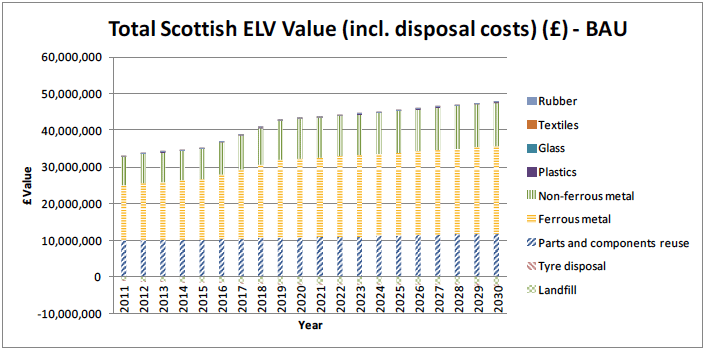
Figure 51 - Total Scottish ELV Value (incl. disposal costs) (£) from 2011 to 2030
In 2011 the total value of ELVs processed in Scotland (net of landfill and tyre disposal costs) is estimated to be almost £32 million. By 2030, this is projected to increase to over £45 million. The net value of an average end of life vehicle in 2011 is estimated to be £327 rising to £385 by 2030 (mainly due to projected increases in average vehicle weight). This value is shared between the final owner of the vehicle, the dismantler and the shredder company.
The main element of value is achieved from income from ferrous metal sales, with income from non ferrous metal being the second largest contributor to total value. Parts and components reuse are the other significant contributor to total value.
Based on these estimates, it is possible to quantify the impact of ELVs being treated by unauthorised operators. For every 1,000 ELVs being treated by unauthorised operators the value lost to the dismantling and shredding sector is £327,000. There are several impacts of this lost value:
- Undermines confidence and ability of the industry to invest
- Leakage of value on a national level due to illegal operations more likely to avoid tax payments
- Greater environmental costs due to lack of proper de-pollution and disposal processes
A significant amount of material is sent to landfill. The model estimates that just over 16,000 tonnes of ASR was sent to landfill in 2011. An estimate based on discussions with the four main ELV shredders in Scotland (combined with data from SEPA in some cases) was around 20,000 tonnes of ASR. This difference suggests that the actual reuse, recycling and recovery figure in Scotland is less than the UK average (less than 80% on this basis) and that the data in the model underestimates the amount of ASR landfilled. Another factor that may account for this difference is that the shredders are likely to be processing some ELVs that were not issued a Certificate of Destruction. It should again be noted that shredders process other metal containing products ( e.g. WEEE) and that total shredder residue (including ASR) in Scotland is estimated to be around 60,000 tonnes per year.
An estimate of the environmental impacts of the recycling and recovery of ELVs can be made. No data are available to enable calculation of the environmental benefits of parts and components reuse so these have not been considered. Note that no environmental benefit has been apportioned to glass recycling as it is assumed to go to aggregate use.
Figure 52, overleaf, shows the estimated environmental benefits from material recycling and recovery from ELVs in Scotland.
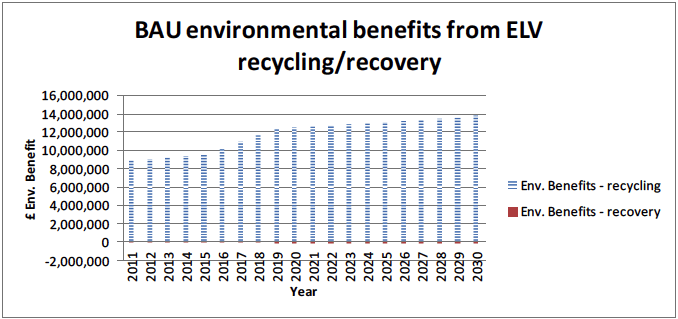
Figure 52 - Environmental benefits from ELV recycling and recovery
The estimated net environmental benefit of material recycling and recovery from ELVs in Scotland is almost £9 million for 2011. The relatively minor environmental cost is due to plastic being thermally recovered as part of the smelting process (for engines, gearboxes, etc.). The net environmental benefit is projected to increase to over £13.5 million in 2030.
Adding the estimated economic value to the environmental benefits suggests that the true social benefit from ELV treatment in Scotland is over £41 million in 2011 rising to almost £59 million in 2030. This equates to social benefits per ELV of £417 in 2011 and £500 in 2030.
8.3 Comparing different short term opportunitiesBased on feedback from industry and discussions with other stakeholders, a number of commercial opportunities have been identified for further analysis. The economic and environmental impacts of these scenarios are then compared against the business as usual scenarios. The scenarios investigated are:
- Scenario 1 - Post Shredder Technology plant
- Scenario 2 - ASR plasma gasification plant
- Scenario 3 - 50% increase in parts reuse
Each of these is now discussed in detail.
8.3.1 Scenario 1 - Post Shredder Technology plantA number of shredders in Scotland have invested in Post Shredder Technology ( PST) to improve recovery rates of ferrous and non-ferrous materials. Others send ASR to third party material recovery facilities for materials to be extracted prior to landfill. The latter process involves the material being processed through hand picking lines to extract metal.
At least three PST plants have been established in England and a significant number in Europe (see earlier section 4.2.3). Approximate investment costs and minimum capacity requirements were identified for two plants. The estimated investment costs are between £20 million and £25 million and the minimum capacity required is between 60,000 tonnes to 100,000 tonnes per annum. If it is assumed that the additional shredder (from processing of WEEE scrap) that is available from the four major shredders is around 40,000 tonnes (based on a combination of shredder feedback and SEPA returns) then the total (60,000 tonnes of shredder residue) is at the lower end of minimum commercially viability. This information about the current commercially viable scale of this type of operation suggests that (based on this current technology) there is an issue with sufficient shredder residue arisings (as at the lower end of commercial viability all the Scottish shredder arisings would be required - leaving the PST plant operator commercially exposed). The model has been developed to demonstrate the scale of the potential economic and environmental benefit, relative to other scenarios.
The existing PST plants identified generate revenue from recovered material sales and face costs associated with material disposal. The estimated values used in the model projections, which differ from those in the business as usual scenario are:
The key assumptions about changes in this scenario compared to the business as usual scenario are:
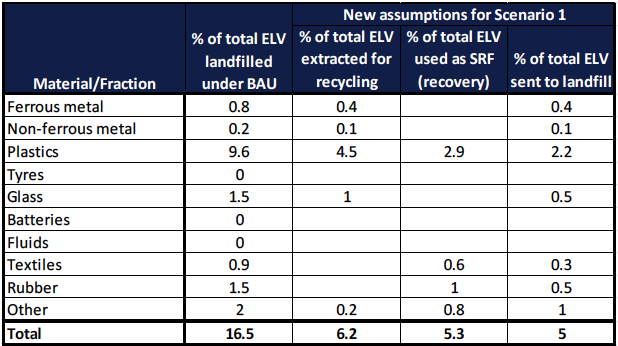
Figure 53 - Assumed changes for scenario 1 compared to the BAU scenario
Given the commercial sensitivity of the actual outputs achieved by ASR processes, it has been necessary to estimate the changes to the business as usual scenario. It has been assumed that 50% of ferrous and non-ferrous metal, currently landfilled, is recycled with the remaining 50% still being sent to landfill (being trapped in small fractions with other material and not being economically viable to separate). Proportions of other materials continue to be landfilled to a level of 5%, meaning that this scenario is consistent with achieving the 95% recycling and recovery target of the ELV Directive. The SRF produced as part of the treatment is assumed to contain fractions of plastic (with minimal residual PVC), textiles, rubber and other material.
Given an estimated investment, planning and build time of two years, it is assumed that the overall reuse, recycling and recovery rate will reach 95% by 2015.
The overall economic value of ELV materials and disposal costs are shown in figure 54, overleaf.
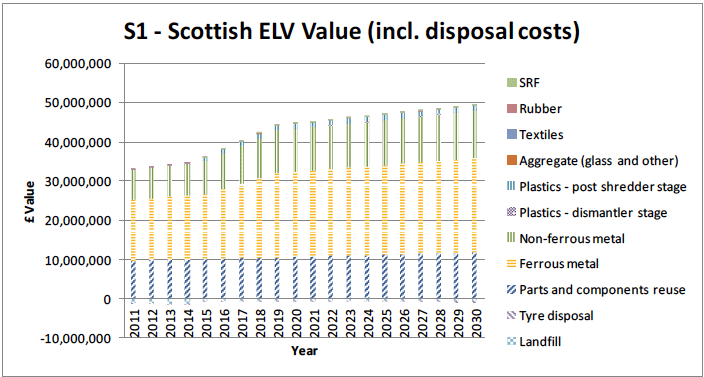
Figure 54 - Scenario 1 - Post Shredder Technology plant - material value and disposal costs
The model projections show an overall economic value of ELV materials (net of disposal costs) of almost £32 million in 2011. In 2015 there is change from the business as usual scenario when more value is recovered from metal and plastic with a reduction in material sent to landfill. By 2030 the model projects an overall economic value of ELV materials (net of disposal costs) of nearly £47 million. Considering this scenario from an individual ELV perspective, the economic value (net of disposal costs) changes from £327 in 2011 to £413 in 2030.
As with the business as usual scenario, the overall environmental impact of material recycling and recovery can be projected. Figure 55, overleaf, shows the environmental benefits of recycling and the costs of recovery expressed in economic terms. As with the business as usual scenario, this does not include the environmental benefits of reuse as no data was identified to enable this calculation to be made.
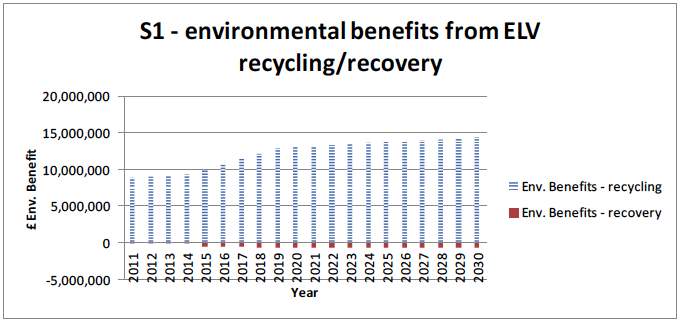
Figure 55 - Scenario 1 - Post Shredder Technology plant - environmental benefits and costs
The net environmental benefit of ELV recycling and recovery in Scotland was almost £9 million in 2011. This is projected to increase to nearly £14 million by 2030. There is a noticeable increase in environmental costs from 2015 onwards associated with the use of plastic material in SRF production and use.
The environmental benefit can also be expressed in terms of an individual ELV. In 2011, each ELV treated resulted in environmental benefits equivalent to £90. This is projected to rise to £115 by 2030. These figures are the same as the business as usual case due to the additional environmental benefits of material being recycled are cancelled out by the additional environmental costs of the material being recovered via thermal treatment.
Considering both the economic and environmental values and costs together results in an overall social benefit to Scotland of ELV recycling and recovery of £41 million in 2011, projected to rise to £62 million by 2030. The equivalent figures at an individual ELV level are £317 social benefit in 2011 rising to £528 in 2030.
8.3.2 Scenario 2 - ASR plasma gasification plantAn alternative to scenario 1 ( PST Technology plant) is the treatment of ASR via plasma gasification. Unlike scenario 1, which involved a plant dedicated to recycling and recovery of ASR, a plasma gasification plant can treat a wide variety of waste feedstocks. The process generates a synthetic gas (syngas) that can be used to generate heat and power by feeding a combined heat and power plant. Some systems can recover metal fractions before the residue is vitrified to an inert, 'glass-like', material that can be used as an aggregate. The technology has been proven in the treatment of ASR in other countries, such as Japan. Discussions with two companies supplying this type of plant suggest that a minimum commercially viable operation would be in the region of 50,000 tonnes per annum. This compares to estimated total shredder residue (from both ELV and WEEE) in Scotland of around 60,000 tonnes per annum. As previously stated, mixed feedstocks can be used with this technology.
The indicative investment cost is thought to be around £20 million with modularised development possible (in 50,000 tonne modules).
Compared to MSW incineration, this technology uses relatively less air in the combustion process meaning relatively less emissions. In the absence of any alternative data, the model uses environmental impact conversion factors based on MSW incineration. This is likely to produce environmental costs that are higher than would actually result from the plasma gasification technology (although no alternative reference source could be dentified).
During the research process, three merchant facilities using plasma gasification technology (at various early stages of planning) were identified in Scotland. At least one of these has already approached producers of ASR with a view to investigating the material as a potential feedstock.
The estimated values used in the model projections, which differ from those in the business as usual scenario are [106] :
- Income from electricity generation - £150 from each tonne of ASR
- Income achieved from vitrified residue used as aggregate - £0
The key assumptions about changes in this scenario compared to the business as usual scenario are:
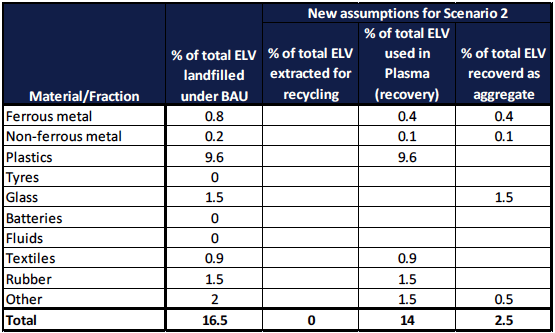
Figure 56 - Assumed changes for scenario 2 compared to the BAU scenario
Scenario 2 assumes no recycling of materials prior to thermal treatment. It is assumed that 50% of the ferrous and non ferrous metal is recovered from bottom ash prior to it being vitrified. In this scenario there is no material residue to landfill.
Given an estimated investment, planning and build time of two years, it is assumed that the overall reuse, recycling and recovery rate will reach 100% by 2015. This assumes that the efficiency of the CHP operation is sufficient to be classed as recovery.
The overall economic value of ELV materials and disposal costs are shown in figure 57, overleaf.
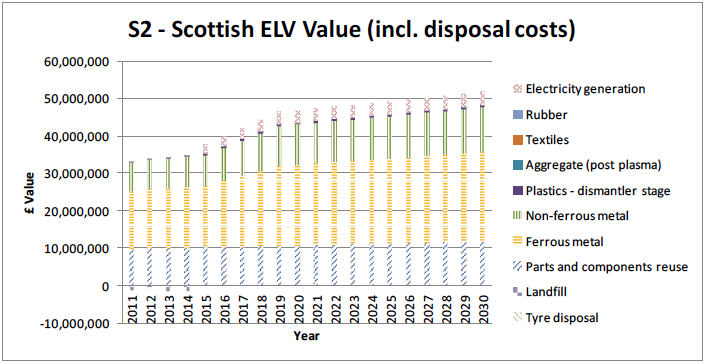
Figure 57 - Scenario 2 - ASR plasma gasification - material value and disposal costs
The model projections show an overall economic value of ELV materials (net of disposal costs) of almost £32 million in 2011. In 2015 there is change from the business as usual scenario when more value is projected from electricity generation, with a reduction in material sent to landfill to zero. By 2030 the model projects an overall economic value of ELV materials (net of disposal costs) of over £451 million. Considering this scenario from an individual ELV perspective, the economic value (net of disposal costs) changes from £327 in 2011 to £438 in 2030.
As with the business as usual scenario, the overall environmental impact of material recycling and recovery can be projected. Figure 58, overleaf, shows the environmental benefits of recycling and costs of recovery expressed in economic terms. As with the business as usual scenario this does not include the environmental benefits of reuse as no data was identified to enable this calculation to be made.
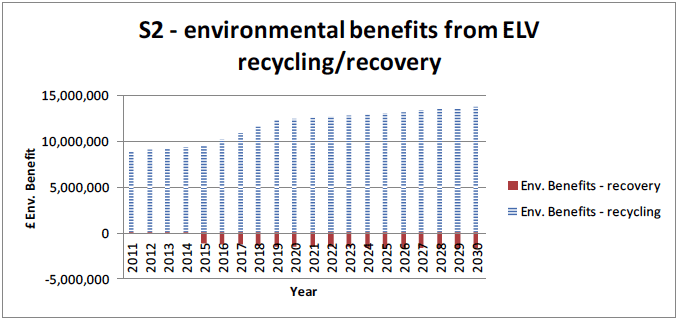
Figure 58 - Scenario 2 - ASR plasma gasification - environmental benefits and costs
The net environmental benefit of ELV recycling and recovery in Scotland was almost £9 million in 2011. This is projected to increase to nearly £12 million by 2030. There is a noticeable increase in environmental costs from 2015 onwards associated with the thermal treatment of the ASR.
The environmental benefit can also be expressed in terms of an individual ELV. In 2011, each ELV treated resulted in environmental benefits equivalent to £90. This is projected to rise to £101 by 2030.
Considering both the economic and environmental values and costs together results in an overall social benefit to Scotland of ELV recycling and recovery of £41 million in 2011, projected to rise to £73.4 million by 2030. The equivalent figures at an individual ELV level are £417 social benefit in 2011 rising to £539 in 2030.
8.3.3 Scenario 3 - 50% increase in value of parts reuseThe third scenario involves a 50% increase in the value achieved from the reuse of parts and components at the dismantler stage. The business as usual scenario assumes an average income from this source of £100 per ELV. The value in scenario 3 is assumed to be £100 until 2013, £125 in 2014 and £150 per ELV from 2015 onwards. All other values remain the same as in the business as usual scenario. The weight of the ELV, which is assumed to be reused, increases from 5.8% to 8.7% over the period 2013 to 2015. The impact of this 2.9% increase in parts and components reuse on the recycling, recovery and landfill rates is shown in figure 59, overleaf.
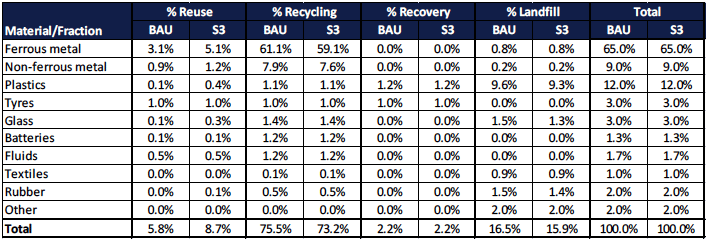
Figure 59 - Assumed changes in rates of recycling, recovery and landfill as a result in increases in reuse
The above figure shows the assumed changes to recycling, recovery and landfill resulting from an increase in parts and components reuse. Recent experience of a pilot in England, involving a number of dismantlers supplying retail service and repair garages, suggested that demand tended to be for items such as glass, bumper mounts, washer bottles, trims and seals (items with high glass, plastic and rubber contents) [107] . The assumed change in material, therefore, includes metal (shifting from recycling to reuse), plastics (shifting from landfill to reuse), glass (shifting from landfill to reuse) and rubber (shifting from landfill to reuse). It should be noted that the reuse of parts and components is finite and the eventual treatment may still include landfill.
The overall economic value of ELV materials and disposal costs are shown in figure 60, overleaf.
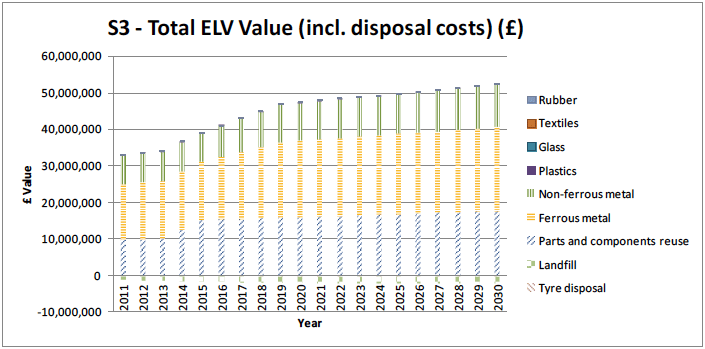
Figure 60 - Scenario 3 - 50% increase in value from parts and components reuse
The model projections show an overall economic value of ELV materials (net of disposal costs) of almost £32 million in 2011. In 2014 there is change from the business as usual scenario when more value is recovered from reused parts (average of £125 per ELV compared to previous average of £100 per ELV). In 2015 there is a further increase in revenue from parts reuse resulting from an increase in the average value per ELV of £150). These increases are partially offset by a reduction in revenues from metal available for recycling (ferrous and non ferrous). Costs are reduced through a reduction in material sent to landfill (plastic, glass and rubber). By 2030, the model projects an overall economic value of ELV materials (net of disposal costs) of just under £50 million. Considering this scenario from an individual ELV perspective, the economic value (net of disposal costs) changes from £327 in 2011 to £425 in 2030.
The environmental impact of this scenario is difficult to compare with the business as usual scenario as there is insufficient data identified to enable the calculation of the environmental impact of parts and component reuse.
The investment costs related to this scenario include the time taken by ATFs to develop a system of supply that is suitable for the target market and also the cost of developing a PAS standard to provide the market with a framework to measure quality of supply. Feedback from industry suggests that the annual certification costs of such a system would be around £2,000 to £5,000 per ATF. It is estimated that around £65,000 would be required to initially develop such a PAS which could be used by the industry and its customers.
There is also potential to support this scenario with policy guidance to help identify and remove (where possible) barriers to the reuse of vehicle parts and components by the public sector.
8.3.4 Comparison of scenario impactsTo isolate the projected impacts of each scenario it is necessary to consider the impacts relative to what may have occurred if the scenarios did not take place, i.e. relative to the business as usual scenario. Comparison is made in economic terms, environmental terms and combined social cost benefit terms. Note that for the environmental and social cost comparisons, only scenarios one and two are included as data was not identified to enable the environmental benefits of reuse to be calculated.
Economic comparison
Figure 61, below, shows a comparison of the projected economic impact (at a Scottish level) of the three scenarios discussed earlier in this section.
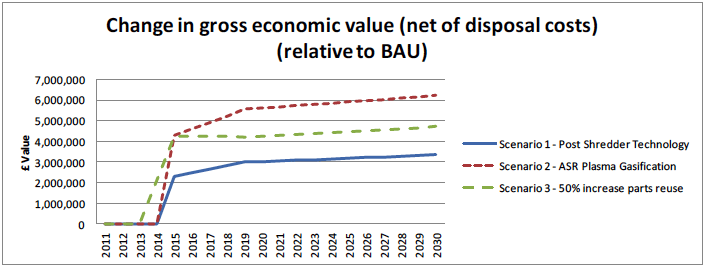
Figure 61 - Comparison of the change in gross economic value (net of disposal costs) relative to business as usual
The above comparison shows that scenario two ( ASR plasma gasification) offers the largest increase in gross economic value at over £6 million per annum by 2030. This compares to over £3 million per annum by 2030 for scenario one ( ASR Post Shredder Technology) and almost £5 million per annum by 2030 for scenario three (50% increase in parts reuse). These relative increases must, however, be viewed alongside the estimated investment costs for each scenario. Scenarios one & two are estimated to require capital expenditure investment of around £20 to £25 million for a PST plant and £20 million for a plasma gasification plant. Scenario three is estimated to require investment of £65,000 (relating to the development of a PAS) plus an additional £274,000 of upfront costs faced by ATFs setting up internal systems to comply with the PAS (based on each of the 137 ATFs incur costs of £2,000 each). Clearly, when considering changes in gross economic value relative to investment costs, scenario three is the best performing scenario.
Figure 62, below, compares the change in gross economic value at an individual ELV level.
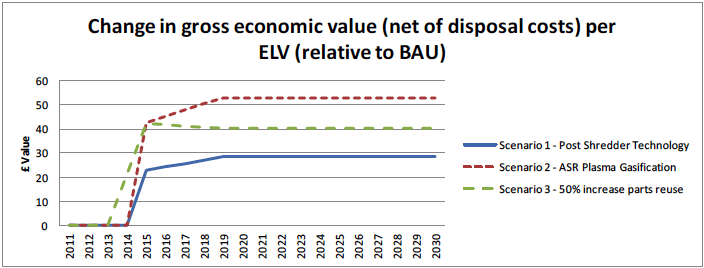
Figure 62 - Comparison of the change in gross economic value (net of disposal costs) per ELV relative to business as usual
The relative comparison obviously remains the same. Scenario three only generates an additional £40 per ELV, even though the average increase in revenue from reused parts and components is projected to be £50. This difference occurs due to some of the metal in the reuse components no longer being recycled. On balance the effect is positive as reused components will attract a higher value than could be achieved if sold for material scrap value.
Environmental comparison
Figure 63, overleaf, shows the comparative change in environmental benefits/costs, at a Scottish level, associated with scenarios one and two, relative to business as usual. Scenario 3 is not included due to the lack of data identified to enable calculation of the environmental benefits of reuse of ELV parts and components.
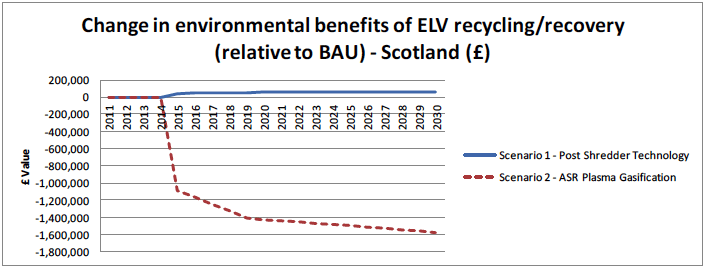
Figure 63 - Comparison of the change in environmental benefits of ELV recycling/recovery (relative to BAU) - Scottish level
The above comparison shows a modest benefit to the environment of scenario one and a significant environmental cost associated with scenario two. The former is due to the environmental benefits of recycling of plastic being almost cancelled out by the environmental costs associated with thermal treatment of residual material as part of the PST output. It should be noted that the environmental costs associated with thermal treatment used in this calculation are estimated from the greenhouse gas and other air emissions from treating plastic via an MSW incinerator (no alternative data for plasma gasification could be identified). Plasma gasification technology uses less air in the process than MSW incineration and, therefore, it is likely that the scale of environmental costs associated with treating plastic using this technology would be less than MSW incineration.
Figure 64, overleaf, shows the same environmental impact data but at the level of an individual ELV.
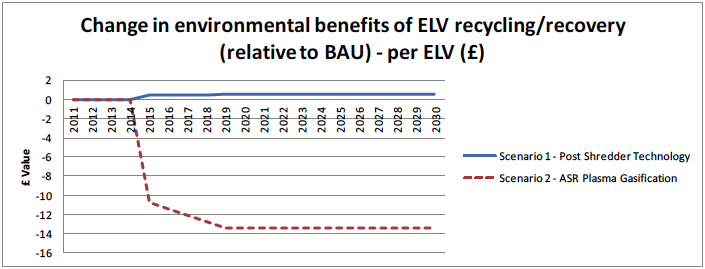
Figure 64 - Comparison of the change in environmental benefits of ELV recycling/recovery (relative to BAU) - per ELV level
Again the above figure shows how the environmental benefits of material recycling through a PST plant are almost cancelled out by the environmental costs of using a proportion of the output as a feedstock for energy from waste facilities.
Social comparison (combined economic and environmental)
Combining both the economic and environmental impact for scenario one and scenario two provides the projected social costs of each scenario. Figure 65, below, shows the comparison of social costs between the two scenarios, at a Scottish level.
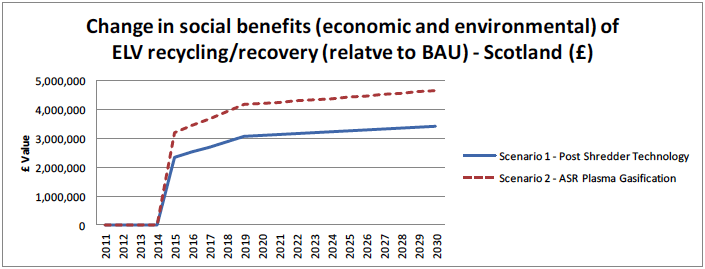
Figure 65 - Comparison of the change in social benefits of ELV recycling/ recovery (relative to business as usual) - Scottish level
The above comparison shows that, even accounting for the relatively significant environmental costs associated with scenario two, the option of ASR plasma gasification offers a greater overall social benefit to Scotland compared to scenario one ( PST plant). Scenario three is not shown as the environmental benefits of parts and component reuse could not be calculated.
Figure 66, below, shows the same data at an individual ELV level.
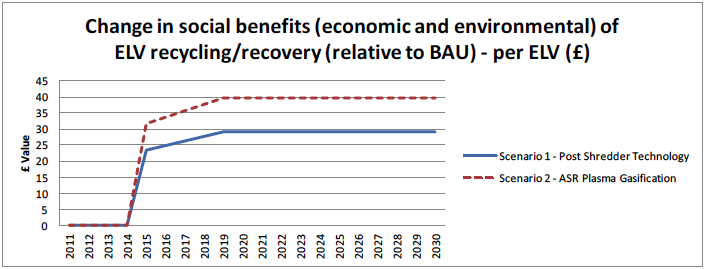
Figure 66 - Comparison of the change in social benefits of ELV recycling/ recovery (relative to business as usual) - ELV level
These projections suggest that scenario two offers an approximate £10 per ELV additional social benefit compared to scenario one.
The figure 67 shows the comparison of key estimated investment and return information based on the modelling.
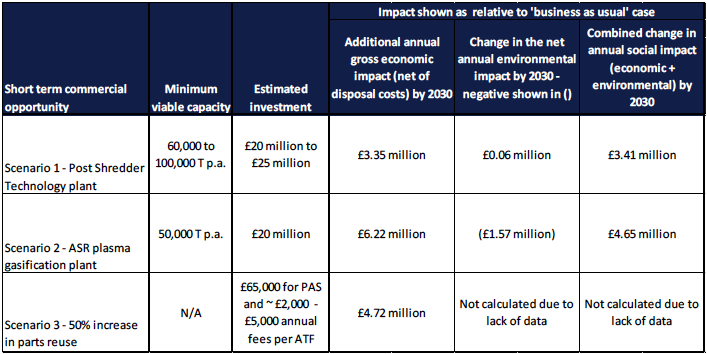
Figure 67 - Overview comparison of short term opportunities
The above figure suggests that the opportunity to increase value from higher levels of parts and components reuse offers a significant return on the initial investment in a Publicly Available Specification for automotive parts and components reuse. Of course, in addition to the initial financial investment in a PAS, there will be significant time and effort required to develop the reverse logistics networks to ensure service and repair garages have access to a sufficient range of quality parts and components at the correct time.
It should also be noted that investment in the Post Shredder Technology plant or ASR plasma gasification plant is based on continuing availability of ASR as a feedstock (although a plasma gasification plant would have more flexibility of input materials than a dedicated PST plant).
Considering these ASR treatment processes alongside the earlier medium to long term opportunities involving a shift to a circular economy suggests that, in the medium to long term, there would be a decreasing supply of shredder residue for these plants to process. The higher value achieved from greater levels of reuse, repair, refurbishment and remanufacture of parts and components would mean that less material would require recycling or downcycling. This presents a risk to investors in this type of plant but would not necessarily lock in the rest of the supply chain to use of these facilities due to the lack of long term contracts in place. Dismantlers are currently free to extract the parts, components and materials they choose from vehicles prior to shredding, and this is likely to remain the case. As demand for more core parts and components for remanufacture increases (for example) then the presence of PST plants and/or plasma gasification plants is unlikely to present a barrier to dismantlers responding to this demand.
Contact
There is a problem
Thanks for your feedback